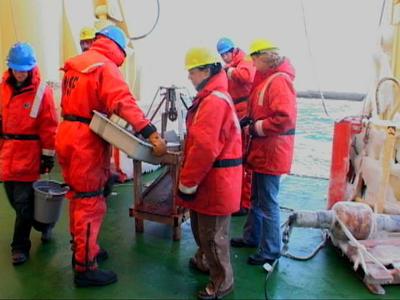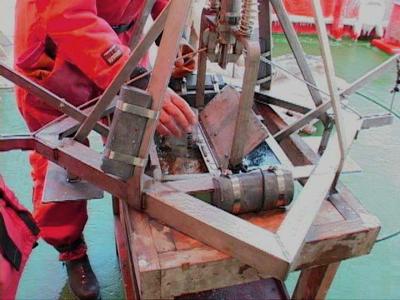
|
|
10 February, 2001
The Smith - Macintyre Grab or "the grab"
Standing by the watch station I heard Christian, our marine technician,
over the radio say, "the CTD is on board; we're ready to send the grab
down". On one of the television monitors you could watch as the winch sent
the Smith Macintyre grab over the side of the ship. Once under the water
we followed the grab's movement on a monitor down, down at 40 meters a
minute. It passed one hundred, two hundred meters; three, four, past five,
then if you were looking closely you saw it: the wobble in the cable that
is the sign that the grab had reached its destination 640 meters below.
The grab is like a large clamp that takes a chunk out of the ocean floor.
The grab sample is fairly easy to collect and right away we can get a
pretty good idea of what the sea floor is like. If it is indeed as good a
site as the other things we did indicated, like the Bathy 2000, we will
collect sediment cores. The hardest part of collecting a grab sample is
waiting as it slowly is pulled out of the mud and brought back to the
surface. We all waited and watched, wondering if the two arms of the grab
tripped and, if so, what would be inside. As it nears the surface the team
assembles and Charlie, our scientist from Colgate University, is the first
to reach it. But he didn't need to go far out on deck as you could see
plainly from the monitor inside that one of the arms was open and all of
the sediment had fallen out. A moment passed; a call was made to the winch
room. Down again. We needed to know what the floor was like before we
committed the big coring devices. Once again Meredith, who was on watch,
took out a log sheet to write down all the vital information: latitude,
longitude, the time the grab went in the water, the time it came back on
deck, the depth of the seafloor, as well as the tension on the wire when
we pulled the grab out. All are pieces of information that, together,
give us clues to the ocean floor beneath us. Slowly the grab rose off the
floor, again the team assembled, donning their polar parkas and hard hats.
This time were not let down the grab came up full. Charlie collected
sediment samples immediately, then others took their turn. It wasn't long
before everything was reduced to sieve pans, each pan holding smaller ands
smaller details; details such as rocks and animal life that might be on
the sea floor. These things, together with the sediment, tell us what type
of environment the sea floor at that parcticular location is like.



Contact the TEA in the field at
.
If you cannot connect through your browser, copy the
TEA's e-mail address in the "To:" line of
your favorite e-mail package.
|
